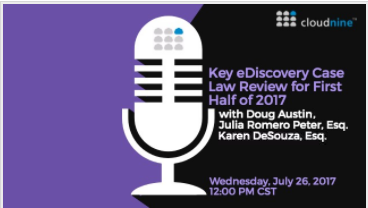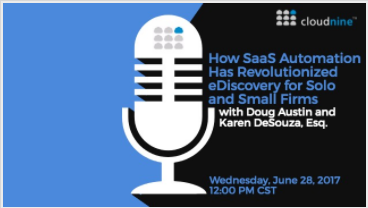Here’s a Chance to Learn How Recent eDiscovery Case Law Has Affected Your Organization: eDiscovery Trends
The best predictor of future behavior is relevant past behavior. Nowhere is that truer than with legal precedents set by past case law decisions, especially when it relates to eDiscovery best practices. Are you aware of recent case law decisions related to eDiscovery best practices and what that those decisions mean to your organization?
On Wednesday, July 26 at noon CST (1:00pm EST, 10:00am PST), CloudNine will conduct the webcast Key eDiscovery Case Law Review for First Half of 2017. This one-hour webcast will cover key case law covered by the eDiscovery Daily blog related to eDiscovery for the first half of 2017, what the legal profession can learn from those rulings and whether any of the decisions run counter to expectations set by Federal and State rules for civil procedure. Topics include:
- How should objections to production requests be handled?
- Are you required to produce subpoenaed data stored internationally?
- Should there be a limit to fees assessed for discovery misconduct?
- When is data stored by a third party considered to be within your control?
- Should courts dictate search terms to parties?
- How can you make an effective proportionality argument to address burdensome requests?
- Can the requesting party dictate the form of production?
- Does storing data on a file share site waive privilege?
- If data is intentionally deleted, should Rule 37(e) apply?
- Is circumstantial evidence of intentional spoliation good enough to warrant sanctions?
- Should keyword search be performed before Technology-Assisted Review?
I’ll be presenting the webcast, along with Julia Romero Peter, General Counsel and VP of Sales at CloudNine AND Karen DeSouza, Director of Review Services for CloudNine. To register for the webcast, click here.
Also, if you’re going to be in Houston on July 20, Women in eDiscovery (WiE) Houston Chapter, in partnership with South Texas College of Law, will be hosting the inaugural eDiscovery “Legal Technology Showcase & Conference” at South Texas College of Law in downtown Houston. I will be participating as a panelist on the “State of the Industry” panel and my colleague, Karen, will be moderating the “Legal Operations and Litigation Support” panel. Click here for more information about the conference, including how to register!
So, what do you think? Do you think case law regarding eDiscovery issues affects how you manage discovery? Please share any comments you might have or if you’d like to know more about a particular topic.

Disclaimer: The views represented herein are exclusively the views of the author, and do not necessarily represent the views held by CloudNine. eDiscovery Daily is made available by CloudNine solely for educational purposes to provide general information about general eDiscovery principles and not to provide specific legal advice applicable to any particular circumstance. eDiscovery Daily should not be used as a substitute for competent legal advice from a lawyer you have retained and who has agreed to represent you.







